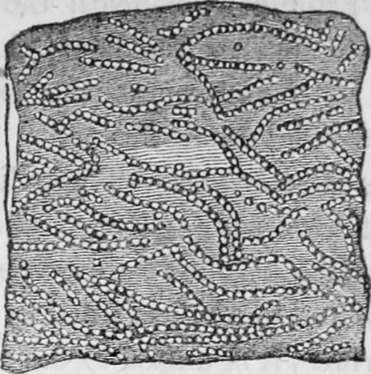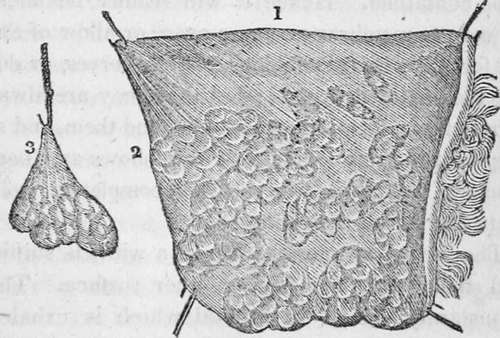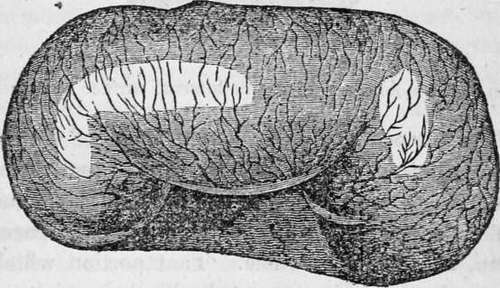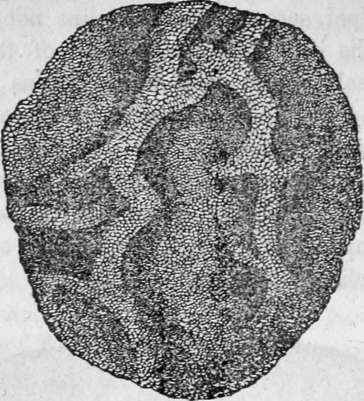Structure Of The Human Body. Part 2
Description
This section is from the book "Human Physiology For The Use Of Elementary Schools", by Charles Alfred Lee. Also available from Amazon: Human Physiology, for the Use of Elementary Schools.
Structure Of The Human Body. Part 2
10. In health, the spaces between these lines are filled with a thin exhalation of a watery nature, which serves to keep the tissue always soft and moist. This is composed of the thinner part of the blood, which is poured out by a process called secretion, but is speedily taken up again by absorption. These two operations exactly balance each other in health, but when from any cause the equilibrium is disturbed, the fluid accumulates, constituting the disease called dropsy. This is often relieved by the operation of tapping, or draw. ing off the water. Cellular membrane is dense or loose, coarse or fine, according to its situation and office. Where it is subject to pressure, as in the palm of the hand and sole of the foot, it is dense and firm ; around the internal organs it is more loose and delicate. Although cellular tissue enters into the composition of all the organs, it never loses its own character, nor participates in the functions of the organ, of which it forms a part. Though present in the nerves it does not share in their sensibility, and though it accompanies every muscle and every muscular fibre, it nowhere partakes of the irritability which belongs to these organs. The microscope shows that the minute particles of this tissue are of a globular figure, arranged like strings of pearls, as repre sented in the following cut.

A portion of cellular tissue, very highly magnified, showing the strings of globules of which its ultimate fibres are supposed to consist.
11. The principal varieties of membrane, which are formed by the cellular tissue, are the adipose, the serous, the mucous, the dermoid, the fibrous, the cartilaginous, and the osseous. The adipose is that tissue which contains the fat which is so disposed as to form distinct bags in which the fat is contained. Now it should be recollected, that while the cells of the cellular tissue are continuous over the whole body, each adipose vesicle is a distinct bag, having no communication whatever with any other. While also, the cellular tissue is universally disposed, the adipose is placed only in particular parts of the body, principally beneath the skin and the abdominal muscles, and around the heart, kidneys, etc. while none is ever found in the cranium, the brain, the eye, the ear, the nose, and several other organs.

1. A portion of adipose tissue : 2. minute bags containing the fat: 3. a cluster of the bags, separated and suspended.
12. The Serous Membranes
These line all the closed cavities, or sacs of the body, and are reflected over the organs contained in them. Thus the cavities of the brain and chest, the abdomen and joints, are lined by serous membrane. By its external surface, it is united to the walls of the cavity, or the substance of the organ it invests ; by its internal surface it is free and unattached ; whence this surface is in contact only with itself, forming a close cavity, having no communication with the external air.
13. If it were possible therefore to dissect serous membranes from off the parts which they invest, they would have the form of a sac, without an opening, the organ invested by one of these folds being altogether external to the cavity of that sac; just as happens when a double night cap is worn, of which the part immediately covering the head is analagous to that portion of the serous membrane which adheres to and invests the organ, whilst the external portion of the cap represents the lining of the cavity in which that organ is said to be contained. Hence it will readily be understood that the serous membranes never open, or allow of any perforation for the passage of blood vessels, nerves, or ducts, to or from the enclosed organs ; but that they are always reflected over them, forming a sheath around them, and accompanying them in their course. It also follows as a necessary consequence, that their free surfaces completely isolate the parts between which they intervene.
14. The serous membranes are of a whitish, shining colour, and smooth on their free or inner surface. They are kept constantly moist by a fluid which is exhaled in a gaseous state from the serum of the blood, whence they derive their name. They are also elastic and extensible, and are said to be destitute of blood vessels and nerves; being composed of condensed cellular membrane. According to Rudolphi, serous membranes line not only the closed cavities of the body, but the interior of the vessels also, and the canals which open outwardly, as the alimentary canal and the air passages, forming a cuticle over the mucous membranes, which line these passages. The uses of the serous membranes are to separate different organs, to diminish friction, and to facilitate the motion or gliding of these parts upon one another, by means of thin smooth, moist, and polished surfaces.

15. Mucous Membranes
These membranes are also another form of the cellular structure, and derive their name from the nature of the fluid, which it is their office to secrete by means of numerous minute glands imbedded in their substance. As serous membranes form a shut sac, completely excluding the air, mucous membranes on the contrary, line the various cavities, which are exposed to the air, such as the mouth, the nostrils, the windpipe, the gullet, the stomach, the intestines, and the urinary organs. Their internal surface, or that by which they are attached to the passages they line, is smooth and dense, while their external surface, or that which is exposed to the contact of the air, is soft and pulpy, like the pile of velvet, or the rind of a ripe peach.

A portion of the stomach, showing its internal surface or mucous coat.
Continue to:
- prev: Chapter III. Structure Of The Human Body
- Table of Contents
- next: Structure Of The Human Body. Part 3
Tags
humans, anatomy, skeleton, bones, physiology, organs, nerves, brain
